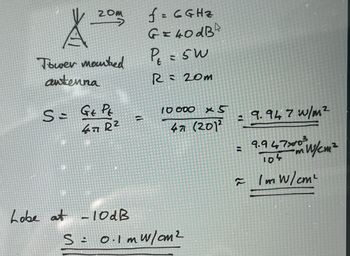
Introductory Circuit Analysis (13th Edition)
13th Edition
ISBN: 9780133923605
Author: Robert L. Boylestad
Publisher: PEARSON
expand_more
expand_more
format_list_bulleted
Concept explainers
Question
How did they get 10000 in working below? Why is the lobe at -10dB?

Transcribed Image Text:A 6 GHz common-carrier microwave communications link uses a tower-mounted antenna with a gain
of 40 dB, and a transmitter power of 5 W. To evaluate the radiation hazard of this system, calculate the
power density at a distance of 20 m from the antenna. Do this for a position in the main beam of the
antenna, and for a position in the side lobe region of the antenna. Assume a worst-case side lobe level
of -10 dB.
Note: The recommended safe power density is as low as 0.2 mW/cm² at the lower RF range of around
100 MHz because the fields penetrate the body more deeply at lower frequencies. Above 15 GHz the
power density limit rises to 10 mW/cm². At 6 GHz the safe limit is 1.2 mW/cm².

Transcribed Image Text:A
Tower mounted
antenna
20m
S = Gt Pt
47 R²
Lobe at -10 dB
=
f = 6GHZ
G=40dB
P₁ = 5W
R= 20m
10 000 x5
47 (201²
S: 0.1m w/cm²
= 9.947 w/m²
9.947x0³
104
≈ /mw/cm²
=
mW/cm²
Expert Solution
This question has been solved!
Explore an expertly crafted, step-by-step solution for a thorough understanding of key concepts.
Step by stepSolved in 3 steps with 2 images

Knowledge Booster
Learn more about
Need a deep-dive on the concept behind this application? Look no further. Learn more about this topic, electrical-engineering and related others by exploring similar questions and additional content below.Similar questions
- You have a complex waveform made up of a 500 Hz signal with an 8Pa peak amplitudeand 0 deg starting phase and a 1000 Hz signal with a 2Pa peak amplitude and 90degstarting phase.a.What is the amplitude of the complex waveform at 15ms?arrow_forwardQuestion 4arrow_forwardPlease describe in specific form the most significant differentiators between typical thermal noise and phase noise.arrow_forward
- In electronics, a clipper is a circuit designed to prevent a signal from exceeding a predetermined reference voltage level. A clipper does not distort the remaining part of the applied waveform. Clipping circuits are used to select, for purposes of transmission, that part of a signal waveform which lies above or below the predetermined reference voltage level. A biased clipper comes in handy when a small portion of positive or negative half cycles of the signal voltage is to be removed. ... Thus a biased negative clipper removes input voltage when the input signal voltage becomes greater than the battery voltage. QUESTION: Where do we exactly need to use a clipper circuit? State at least 3 examples and why it's needed on that application or device.arrow_forwardHIGH J QO Q1 CLK CLK CLK K K FF0 FF1 CLK QO Qla Qlb Qlc Qld Figure 9-1 The counter shown in Figure 9-1 is a(n) counter, and the correct output waveform for Q1 is A asynchronous, Q1c B synchronous, Q1b synchronous, Q1d D synchronous, Q1a asynchronous, Q1barrow_forwardwhat is the use of boronarrow_forward
arrow_back_ios
arrow_forward_ios
Recommended textbooks for you
 Introductory Circuit Analysis (13th Edition)Electrical EngineeringISBN:9780133923605Author:Robert L. BoylestadPublisher:PEARSON
Introductory Circuit Analysis (13th Edition)Electrical EngineeringISBN:9780133923605Author:Robert L. BoylestadPublisher:PEARSON Delmar's Standard Textbook Of ElectricityElectrical EngineeringISBN:9781337900348Author:Stephen L. HermanPublisher:Cengage Learning
Delmar's Standard Textbook Of ElectricityElectrical EngineeringISBN:9781337900348Author:Stephen L. HermanPublisher:Cengage Learning Programmable Logic ControllersElectrical EngineeringISBN:9780073373843Author:Frank D. PetruzellaPublisher:McGraw-Hill Education
Programmable Logic ControllersElectrical EngineeringISBN:9780073373843Author:Frank D. PetruzellaPublisher:McGraw-Hill Education Fundamentals of Electric CircuitsElectrical EngineeringISBN:9780078028229Author:Charles K Alexander, Matthew SadikuPublisher:McGraw-Hill Education
Fundamentals of Electric CircuitsElectrical EngineeringISBN:9780078028229Author:Charles K Alexander, Matthew SadikuPublisher:McGraw-Hill Education Electric Circuits. (11th Edition)Electrical EngineeringISBN:9780134746968Author:James W. Nilsson, Susan RiedelPublisher:PEARSON
Electric Circuits. (11th Edition)Electrical EngineeringISBN:9780134746968Author:James W. Nilsson, Susan RiedelPublisher:PEARSON Engineering ElectromagneticsElectrical EngineeringISBN:9780078028151Author:Hayt, William H. (william Hart), Jr, BUCK, John A.Publisher:Mcgraw-hill Education,
Engineering ElectromagneticsElectrical EngineeringISBN:9780078028151Author:Hayt, William H. (william Hart), Jr, BUCK, John A.Publisher:Mcgraw-hill Education,

Introductory Circuit Analysis (13th Edition)
Electrical Engineering
ISBN:9780133923605
Author:Robert L. Boylestad
Publisher:PEARSON

Delmar's Standard Textbook Of Electricity
Electrical Engineering
ISBN:9781337900348
Author:Stephen L. Herman
Publisher:Cengage Learning

Programmable Logic Controllers
Electrical Engineering
ISBN:9780073373843
Author:Frank D. Petruzella
Publisher:McGraw-Hill Education

Fundamentals of Electric Circuits
Electrical Engineering
ISBN:9780078028229
Author:Charles K Alexander, Matthew Sadiku
Publisher:McGraw-Hill Education

Electric Circuits. (11th Edition)
Electrical Engineering
ISBN:9780134746968
Author:James W. Nilsson, Susan Riedel
Publisher:PEARSON

Engineering Electromagnetics
Electrical Engineering
ISBN:9780078028151
Author:Hayt, William H. (william Hart), Jr, BUCK, John A.
Publisher:Mcgraw-hill Education,